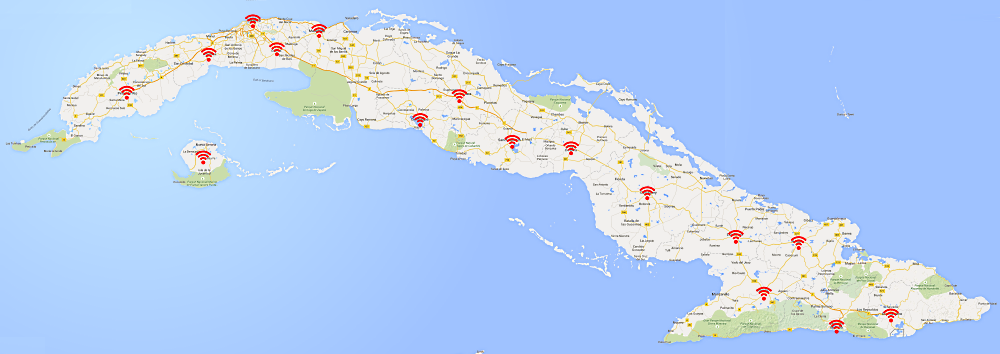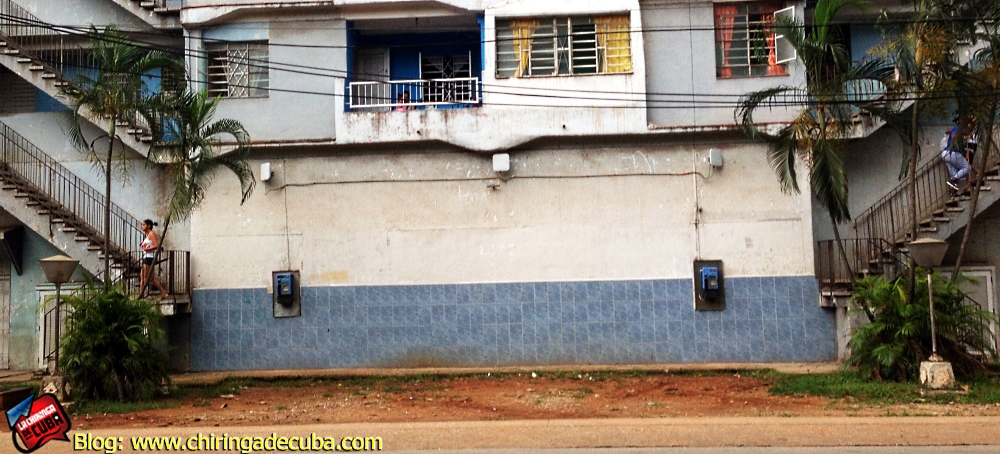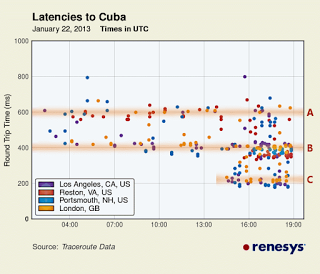aNewDomain — Is it the beginning of a backbone? Maybe. That sure is a takeaway from ETECSA Director of Communications Luis Manuel Díaz Narajano’s announcement of Cuba’s plan to distribute 35 Wi-Fi access points throughout the island this summer. But the new Wi-Fi access plan leads to a number of other questions regarding the Cuba’s telecom future and regarding the probable U.S. and Chinese partners …

According to Díaz, the access points will be able to accommodate 50-100 or more users at once, with speeds of “up to 1 megabyte per second.” I’m assuming he means a megabit, not a megabyte …
At any rate, ETECSA plans to cut the hourly access fee for users to 2 CUC, that’s about $2 U.S. per hour. This rollout, by the way, is just the next step of the January 2015 trial that took place in Santiago de Cuba.
The access points are not operating yet, says Dias. But Carlos Alberto Pérez of Chiringa de Cuba said he is seeing necessary equipment at one of the locations in Havana. From the looks of it, the equipment is being supplied by the Chinese telecom firm Huawei (see below photo). That’s bad news for U.S. telecom companies trying to get in on the ground floor of the island’s nascent Internet and telecom industry.

But I have tech questions.
All this certainly opens up some larger questions, the likes of which I’ve been trying to answer.
For one, how does Cuba achieve backhaul speeds that support 50-100 plus users at the same time, all up to 1 Mb/s? Clearly some access points will be more powerful than others, and that begs another how?
If you assume ETECSA allows international access to the Internet, then you need to ask: Why are some of these access points linked to satellites, while others are linked to the undersea cable?
And how is the link made from the access point to the international connection — fiber, copper, wireless, a combination of them? The answer will differ for each access point.
And here’s another nagging question: Does the above map look like the outline of a future national fiber backbone? It does to me.
I have seen a couple of presentation slides showing a four-phase “planned” fiber backbone that will connect many of the cities on that map, which are now outfitted for Wi-Fi. Eight of the access-point cities are included in the first phase.
Yet another question has to do with the equipment vendor, Huawei. Lina Pedraza Rodríguez, Cuban Minister of Finance and Prices, has said that Cuba is in “very advanced” negotiations with Huawei. This was at the World Economic Forum on Latin America. Now, could she have been referring to the wireless and backhaul equipment for these access points? Might she have been thinking of a possible upgrade to DSL of Cuba’s telephone central offices, as suggested by the announced plan to make low-speed broadband connectivity available to half of the homes in Cuba by 2020?
Or could she have been thinking of the plan to connect all Cuban schools or even a national fiber backbone like the one in the slides I saw?
Regardless, one wonders how the work will be financed, and what sort of concessions ETECSA has made. What does all this mean to U.S. telecommunication equipment and service providers who hope to do business in Cuba? I assume the installation is being done by ETECSA employees. I figure they are hiring some of the folks who have been building out unauthorized Wi-Fi LANS. At least I hope they are.
Finally, and this is my big question, will Cuba eventually try to block the peoples’ access to some sites and services? Currently, Freedom House ranks the Cuban Internet as not free — for obvious political and cultural reasons. And there’s also the possibility Cuba will want to continue that, and block access for economic reasons, too. For example, Skype and FaceTime are blocked in Cuba. Could that be to protect ETECSA phone call revenue? Could be. After all, Skype recommends 100 KB/s upload and download speed with reasonable latency. Doug Madory has shown that Cuban undersea cable links have a latency of around 200 milliseconds, which means that Skype could work for international calls from cable-connected access points. If allowed.
 Certainly other nations have faced this same tradeoff. My favorite example was India during the mid 1990s. At the time, voice calls over the Internet (VoIP) were explicitly illegal, yet shops offering the VoIP service advertised in the newspaper and had promotional signs for them on storefronts. Clearly, there is illegal … and illegal.
Certainly other nations have faced this same tradeoff. My favorite example was India during the mid 1990s. At the time, voice calls over the Internet (VoIP) were explicitly illegal, yet shops offering the VoIP service advertised in the newspaper and had promotional signs for them on storefronts. Clearly, there is illegal … and illegal.
So yes, by Cuban standards at least, this is looking like a major rollout. It’s a drop in the bucket. Whether the latest Cuban telecom developments signify a policy shift really has to do with the goal of the Cuban government. Is the goal to remain in power, maximize ETECSA profit, government profit and transfer wealth to ETECSA investors? Or is it to provide affordable, modern Internet connectivity to the Cuban people?
For aNewDomain, I’m Larry Press.
Ed: A version of this story ran on Larry Press’ laredcubana. Read it here.













